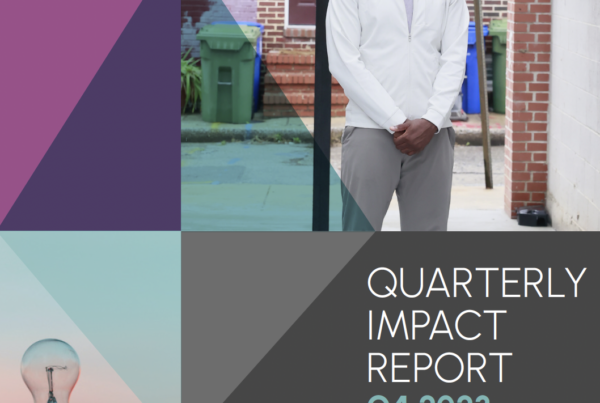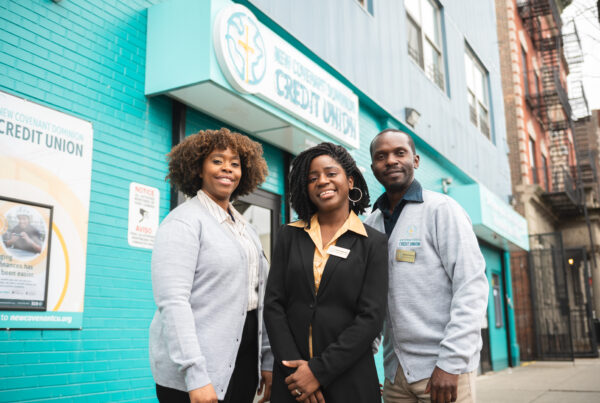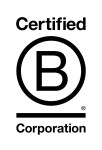In June our co-founder, Cat Berman, sat down with the people over at Gimlet Media’s “The Pitch” to discuss CNote.
The 20 minute discussion that followed provides a great overview of CNote.
If you are a finance junkie, wannabe venture capitalist, or are at all skeptical about CNote, you’ll want to listen.

The format of The Pitch is that multiple professional investors peppered Cat with questions about CNote to get to the core of the company, and to see if they thought it was a promising investment. By the end, you’ll have a great idea of how CNote works, and how it can deliver a better return while driving a positive social impact mission. You’ll also get a better feel for CNote’s culture of transparency and our mission to democratize finance.
We want you to feel comfortable about your investment in CNote so we always try and be forthcoming and transparent. This podcast is great because it lays CNote bare for the world to see. Spoiler alert: there’s no magic involved, we’ve just made a historically reliable investment product accessible to all investors when it was previously only available to big banks and foundations.
Imagine a world where all your financial institutions were this transparent. That’s the world of finance CNote is working to build. Join us.
Thanks again to the people over at Gimlet Media for giving us a platform to share our story. You can read the full transcript below.
Odds are, that after listening to the podcast, you’ll know more about CNote and CDFIs then you ever wanted. If you still want to learn more, you should visit our FAQ and our Risk & Return Page.
SHOW TRANSCRIPT
Welcome to The Pitch. I’m your host, Josh Muccio. Today we’ll be hearing from a startup that’s here to rescue your savings account from the clutches of interest rate hell.
Like we always do on The Pitch, we’ll be listening in as today’s founder Cat Berman pitches her startup to investors.
Cat Berman: If any of you have savings in traditional banks, you’re actually losing money.
That’s Cat. We’ll get to hear her pitch in a moment. Investors will ask the founder a series of tough questions. And then on the second half of our show, we’ll hear what they like and dislike about Cat’s startup. Those investors today: my co-founder Sheel Mohnot, Mar Hershenson with Pear Ventures, and Alex Davidov with Core Innovation Capital.
Here’s the pitch from Cat.
Cat: So CNote is a high-yield savings accounts delivering a return 13 times better than traditional banks. I’m guessing some of your listeners actually probably have this problem. If any of you have savings in traditional banks, you’re actually losing money. Banks can’t get keep up with the current rate of inflation, and so we developed a high-yield savings product that is 2.5% yield, principal insured, no fees.
Sheel: Cool. Tell us about…
This is Sheel Mohnot, my co-host and investor at 500 Startups.
Sheel: Tell us about how that happens, how that works.
Cat: The way we do it, we like to say that we’re flipping traditional savings on its head. Right now when you deposit your savings, it goes to the bank, banks lend it out, and they give you a fraction of the interest that they make. What we’re doing is the same thing. Lending it out with a government-backed product. But we’re giving you the majority of the interest that we earn. And we do that through something called the CDFI – Community Development Financial Institution.
Sheel: Is there a holding period? Is it fully liquid? How does that work?
Cat: Great question. Quarterly liquidity. We like to say we’re not your ATM. So we’re right between your ATM account and a CD. Quarterly liquidity with a threshold, but our real game is to get to full liquidity.
Alex Davidov: What’s the mechanism of the guarantee?
Alex Davidov, investor at Core Innovation Capital.
Alex: Who actually guarantees it, and how does that work?
Cat: A variety of guarantees backed by the government, including the US Treasury Department, MESBA* and state by state.
Mar Hershenson: What’s the volume –
That’s Mar Hershenson, an investor at Pear Ventures. Which, for the record, I hate pears. Don’t send me pears. But Pear Ventures, on the other hand, I like.
Mar: What’s the volume of the CDFIs? Just in general, in the market.
Cat: Great question. So it’s a $100 billion CDFI industry. They’ve been around for over 20 years. A great history behind that. It’s a pretty mature industry at this point.
Alex: What are your economics? How much of that do you take?
Cat: You know, I feel like we have learned a lot from folks who have come before us. So what we decided to do was instead of taking fees – assets under management – we wanted to play a different game. So we decided what we’d do was we’d earn our revenue by the spread that we negotiate from CDFIs. So for example right now your 2.5%, that’s zero fees. We’re going to get 50 basis points just through our CDFI spread. That’s actually going to increase in 2017 to 1% and ultimately to 2%. So the minimum we’re operating on a 2% spread game.
Sheel: How do you plan to acquire users. Or are you live?
Cat: We’re in a private beta right now. We successfully have $100,000 under management. Good private beta. And then next month we actually roll out and go live. We have about 400-plus users on our wait list, who have already given about $3 million in savings, committed capital. So very excited to absorb all of that. But customer acquisition is key. And for us, it’s one of the reasons we decided not to reinvent this, not to become our own borrowing network, per se. Because we wanted to just focus on the customers, just focus on their needs, and frankly just focus on their acquisition. So we have three channels, three main ways for doing customer acquisition. Number one, direct to consumer, which is a referral strategy. So we have a very competitive referral strategy rolling out next month that is tied to yield. And secondly, and I’m a bigger fan frankly of scale customer acquisitions, not just person by person. So for that, we’re actually doing two different channels. One is we are in good negotiations with a few wealth platforms that you may know. Because as you can imagine they don’t have a high-yield option like this. And then secondly, and this is really interesting, is wealth advisors. So we’ve been approached, gratefully, by a lot of wealth advisory firms looking for a) a new cash management tool for them. And then b) and this has been interesting, too, family offices looking for a low risk, high impact product. Because CDFIs work directly with underserved communities like women and minorities, it’s a great impact product.
Mar: What’s the historical performance of these CDFIs?
Cat: So the ones that we’re working with, partnering with, have less than a 3% default rate, less than a 1% net charge back rate. And fared well in the recessions. It’s one of the key things we look for.
Sheel: So you can deliver 2.5 – 3% return. And that’s great. That’s well beyond market. But going back 10 years ago, CDs returned far better than that.
Cat: I remember.
Sheel: So if we return to a high interest rate environment, what happens to the business?
Cat: Yeah, that’s what I love about this. It’s actually tied to prime. So everybody goes up.
Alex: We talked about the risk of default. How does it connect to the guarantee? Who bears that loss?
Cat: So these guarantees are actually loan loss reserves. So what happens when there’s a default, and obviously with less than 1% net charge back rate there’s not a lot, when there are that’s when the government steps in covers those defaults.
Alex: And how much does the government pledge?
Cat: Typically 80% and the CDFI pledges the additional 20%.
Mar: Is there a minimum investment for a retail investor?
Cat: There isn’t right now.
Sheel: So you said right now it is quarterly liquidity; I think it’ll be key to get full liquidity. What do you need to do to make that happen?
Cat: Wow. Longer conversation. There’s a couple of things that we’re doing in terms of negotiation with CDFIs. So the more volume we have with CDFIs, the more opportunity we have to play with that liquidity. We’re also testing a new insurance fund that I can’t tell you too much about, but it’s pretty exciting. It’s actually a model that’s been used around the world to kind of backfill liquidity, if you will.
Alex: When you think of the portfolio of someone’s assets, that’s like a home, savings, equities, bonds, what’s the right allocation to hold in this type of asset?
Cat: We’re calling it fixed income at this point. So if you want to say 10% or 20% to be conservative.
Mar: Are you guys selecting the people that get loans through the CDFIs?
Cat: No. This is a key problem. So our core is the diligence of the CDFIs. They’ve been doing a phenomenal job for several years. So we’re not going to step in and pretend to know better than they are. I think it’s one thing we’ve learned from our friend in the marketplace, the peer-to-peer market. So we want to allow them to do the amazing work they’ve done. Now that said, we have a very stringent diligence. We have a three-part diligence process with CDFIs, including our senior management team, including third-party audit, and including Aeris which is the industry rating agency. It’s not easy to get in with us, but when you do the work you do.
Sheel: Is there any different tax treatment under CDFIs?
Cat: No, not yet.
Alex: So where do you go from here? This is the first product. What happens next?
Cat: My favorite question. Really, what we’re going after, is the entire low-risk investment market. And if I can take a moment to speak about that. So before I launched this, this is my third company, and I took a break after my last company to get into the world of finance. Because I was just fascinated by the flow of capital. I went into venture for about four years. And then I got poached by Charles Schwab to come run a strategy division. And it’s at Schwab where I learned that I kept getting pitched by companies innovating in the equities market, there were platforms about trading, there were roboadvisor enhancements, but nobody was talking to me about this low risk end of the spectrum. And here my job was to look at new investor segments and see the future of finance. And we’re ignoring millions of Americans who value consistency, safety, reliability, who actually don’t want all the volatility that the market brings. Not to say it won’t be a part of their portfolio. What about the rest of the folks who are actually looking for something that feels more moderate, low risk, but is reliable? And so when I realized nobody was innovating in this space, I thought that’s the real opportunity here. I want to completely transform that low risk investment product space. So we’re starting with CDFIs, $100 billion industry, so we have a long way we can go with CDFIs. This is just the first product, this savings product. We actually are already in negotiations for several other low risk products coming out that will be competitive with peer-to-peer lending, frankly. And then we’re also looking at other partners to absorb as we look into owning that low-risk space.
Alex: What’s the rest of the team?
Cat: They’re fantastic. A dear friend of mine, I’ve known for years, Yuliya Tarasava. She’s developed financial products on three continents, former Wall Streeter, just brilliant mind. So she’s my COO. And then the excellent VP of engineering, he was the lead engineer behind Citrix GoToMeeting, and senior software developer at Lending Club.
Mar: Maybe you can talk about your technology advantage, if you have a technology advantage versus a traditional bank. Where is your edge? Or are you just saving on that spread, basically?
Cat: Initially, we’re based on ASW. We’re just kind of a typical platform. I think moving forward there’s a real opportunity to involve technology in this, especially as it relates to savers. Most people ignore how folks are dealing with liquidity. And so I can’t speak too much about it but there are a lot of ideas that we have in terms of bringing in a more competitive technology approach to this and really be your partner as it relates to that low risk end.
Mar: Okay. So this would be technology for the people basically purchasing this product?
Cat: That’s right.
Mar: Okay. Got it.
Cat: The other thing I’ll say, our big picture is we think there’s tremendous opportunity to also advance the entire CDFI industry. So we talk about $100 billion. I think there’s tremendous growth in that that can actually be enhanced through technology. So that’s from also a back-end provider, it makes us a huge competitive advantage, incredibly defensible and obviously a value-add for the CDFI industry.
When we come back, Cat leaves the room and investors Sheel, Mar and Alex decide whether or not they’ll pursue investment in CNote. But first I’d like to say thank you to our sponsor.
[sponsors]
Welcome back to The Pitch, with CNote. Let’s head back into the studio. Cat just left the room. Here’s Sheel, Mar and Alex.
Sheel: Cool, so what do we think, guys?
Alex: I like her.
Sheel: Yeah, I like her too.
Alex: I know her previously, but I think she’s really on top of the business. She really understands all the ins and outs and the types of questions that we’re going to ask. So from a team perspective that’s pretty cool.
Mar: Solid. Yeah, I mean, I think for me the key question is what’s their edge, at the end of the day.
Sheel: Yeah.
Mar: That’s why I was asking about their tech stack. It sounds like it’s a TBD* rather than an existing thing.
Sheel: Yeah. I feel that way. I really like it. I think that for me customer acquisition is going to be key. So if your spread isn’t that high and most people don’t save much money, so how do you make enough to attract people through?
Alex: A little bit of it is also going after institutions and also consumers at the same time. I think to make this big, you’ve got to build a real brand, and you need to get that share of wallet. I think with all these alternative financial products the challenge is, you know, you can get people to throw in $100, $500, but it’s very hard to get them to give you the lion’s share of their savings into something that’s maybe unfamiliar. And I think that requires some consumer DNA that I think is necessary to bring on to that team.
Mar: I completely agree with you guys. It’s a big unknown how expensive it’s going to be to build this brand. But my sense is it’s going to take a lot of dollars to actually build that.
Sheel: It’s hard. And that being said –
Mar: It’s possible.
Sheel: It’s possible. And Digit has acquired a lot of people into its savings product. Of course, it’s a totally different product. But I’d say I’ve been surprised at how they’ve been able to get people in.
Mar: Yeah, I like her vision a lot. About being the alternative investment for these high risk customers.
Sheel: Yeah. I’m going to follow up with her, I think. She’d be a great fit for 500 FinTech, the next batch.
Mar: I think so.
Alex: Yep.
Sheel: What do you guys think?
Mar: Especially you guys can help them with acquisition.
Sheel: Yeah. Exactly.
Mar: But yeah, the vision is great. I like that she has in mind more than just one product. It’s not just CDFIs but she wants to go and –
Sheel: Be savings. All sorts of…
Alex: And I wonder if this, I think this is probably good timing, you know. Still people are kind of fresh from the financial crisis, having lost a lot of money in that process, and now you’re talking about a very low-yield environment, so maybe this is the right time to get people around this sort of low risk mindset.
Mar: I also think community development appeals a lot to the millennials. So there’s a sense like you’re doing something good, something that she can definitely use in customer acquisition.
Alex: Yeah, there’s a story behind that, right? So each of the CDFIs have loaned to some small business or some organization.
Mar: Absolutely.
Alex: Yeah, totally.
Mar: I mean, it seems like she’s detached from the personal story because she’s going through these CDFI funds, but getting those personal stories up front. Every time you put a person instead of an asset –
Sheel: Makes people feel good.
Mar: People are more likely to invest, right.
Sheel: Maybe there’s something where like, actually market where your money is going.
Mar: To lower that acquisition cost.
Sheel: There’s an increasing backlash against banks for almost a decade, and the Wells Fargo news from last week is not helping.
Mar: Right.
Sheel: So I’m increasingly willing to bet on companies that are doing things differently than banks. And I think there’s a growing portion of the population that could be interested in this.
Mar: So it’s a matter of running some tests and trying to figure out back of the envelope calculation, can you acquire some customers?
Sheel: Yeah, exactly.
Alex: Yeah, you really do need to grow assets pretty large for the economics to make sense. At 1% spread, or 50 basis points, if you get someone to put in $10,000 that’s $500 a year. That’s decent, but the acquisition cost for places like Wolfram and Betterment are very significant.
Sheel: Totally.
Mar: Yes.
Sheel: I’m thinking about it from the standpoint of like, so Digit – they think they can make 1% on savings. Which I was never that impressed with but the numbers actually look really good. They’ve been able to acquire a lot of users. So anyway, same spread here. So cool. Sounds like you guys are pretty intrigued, interested, you would like to learn more?
Mar: I gave her my card.
Alex: Definitely.
Sheel: Cool. Thanks guys.








